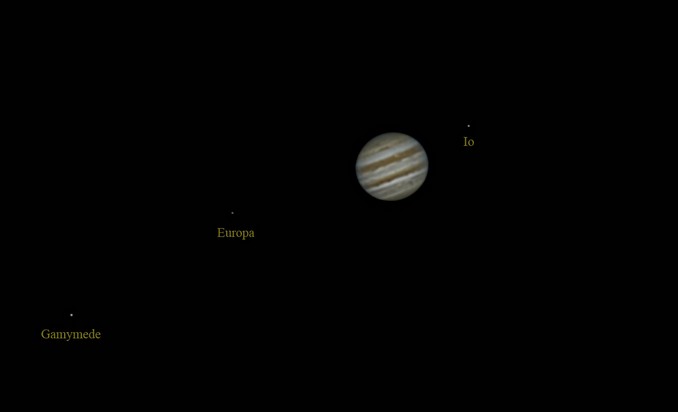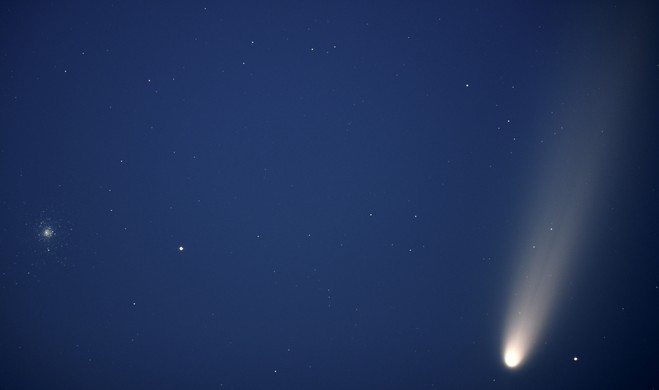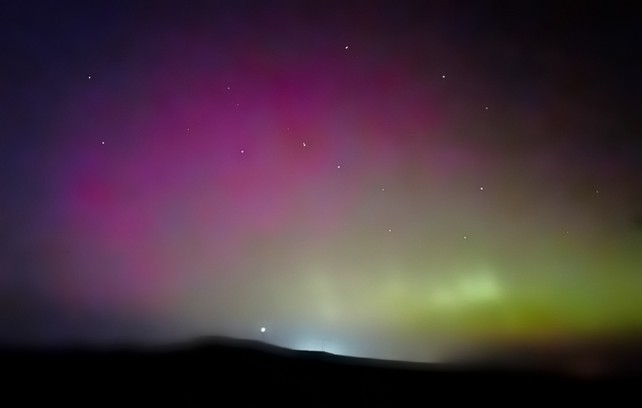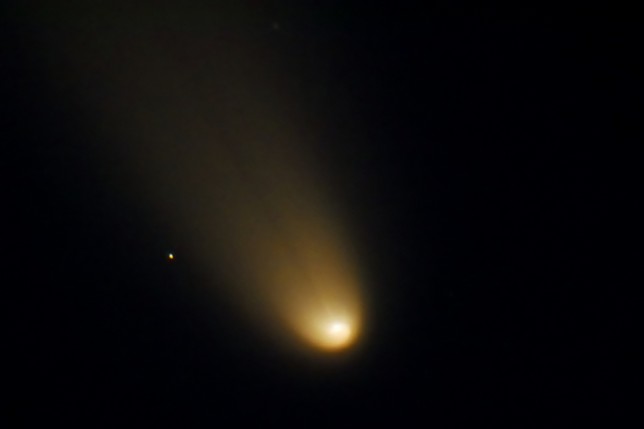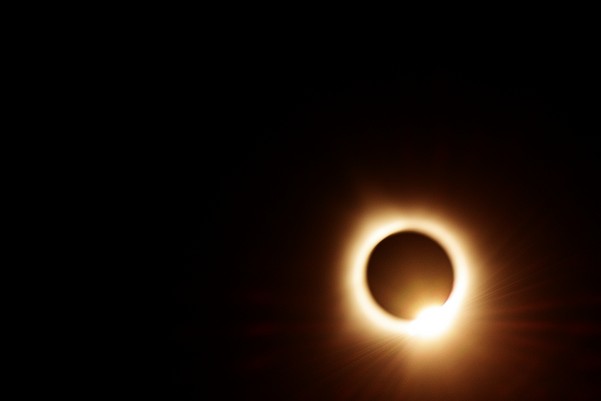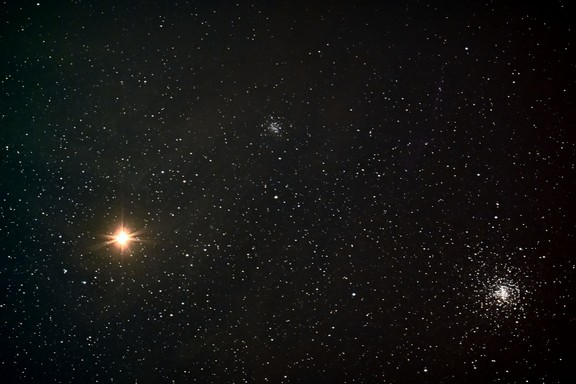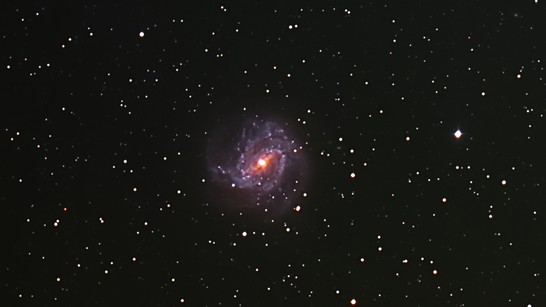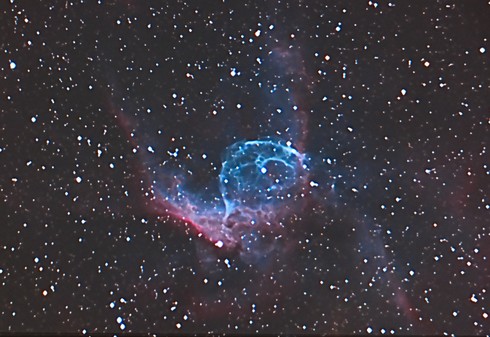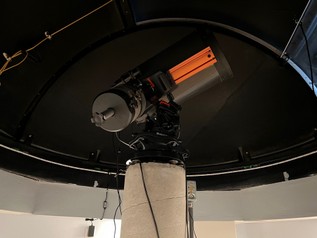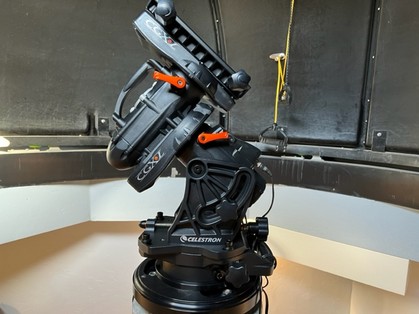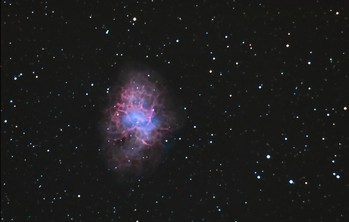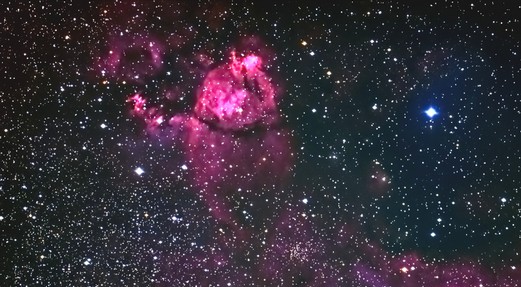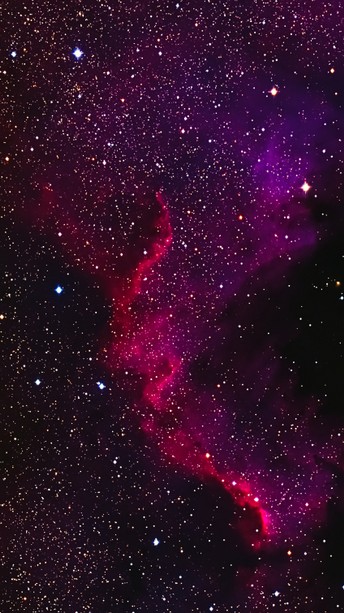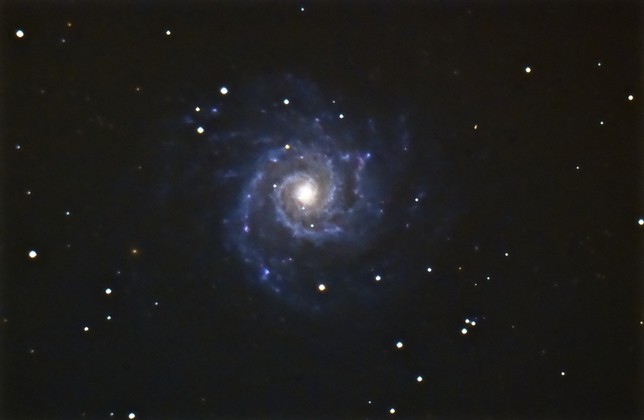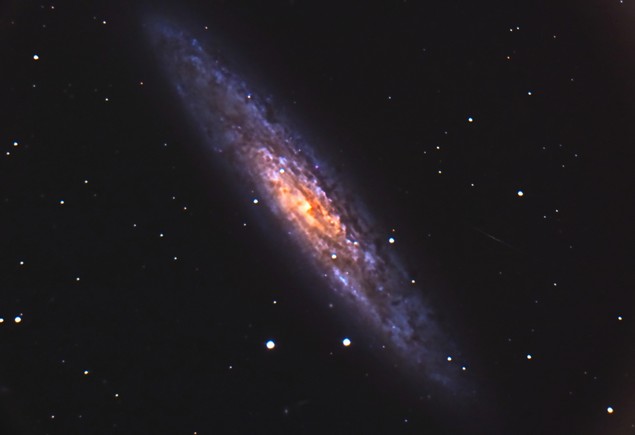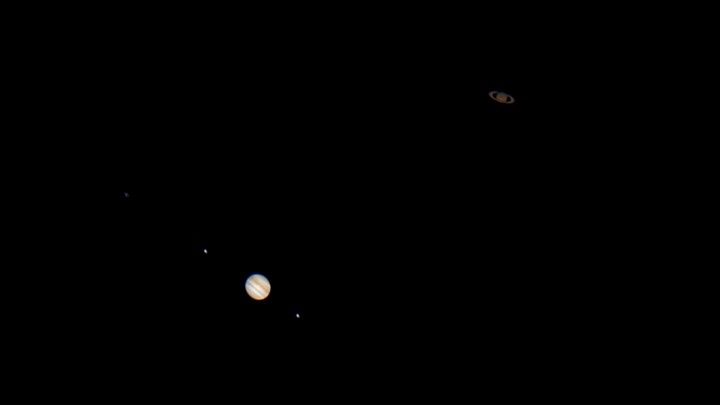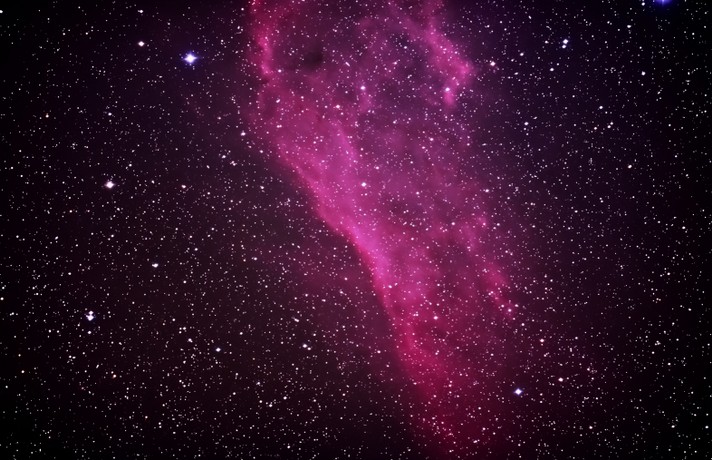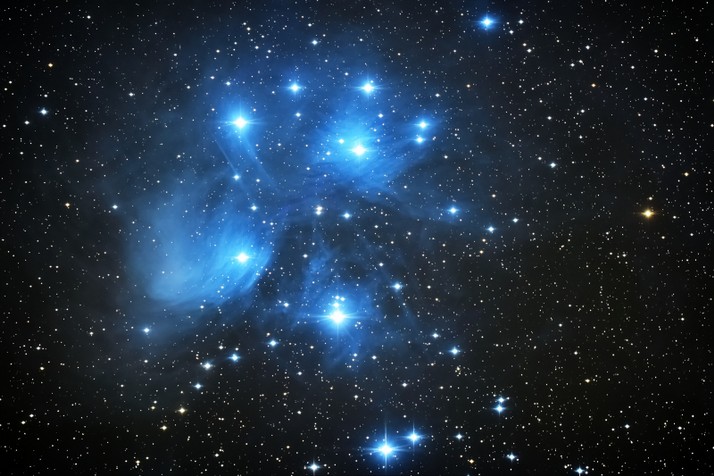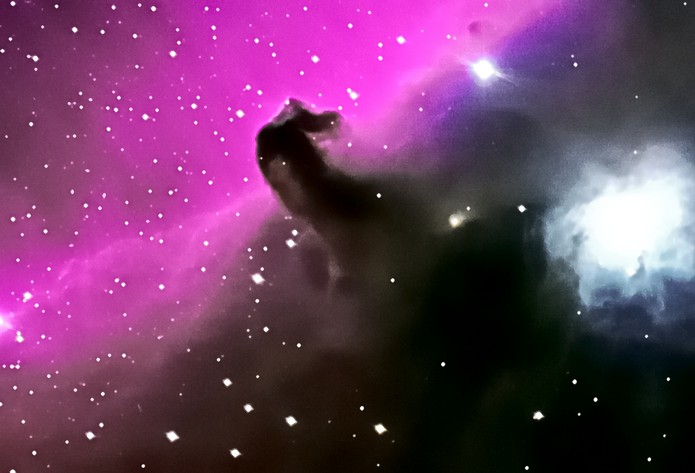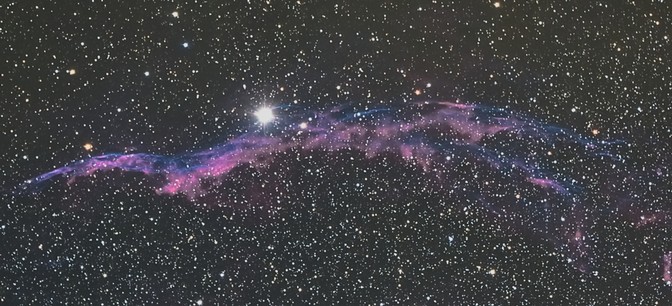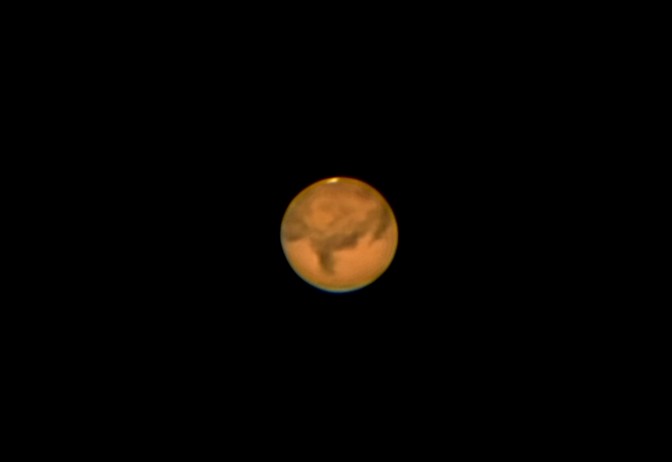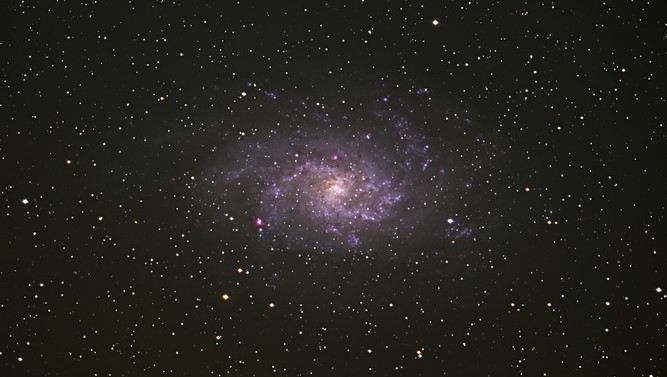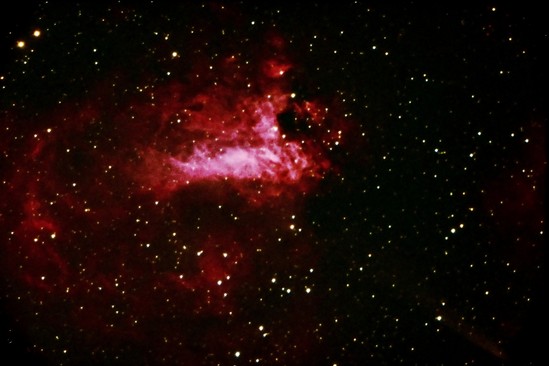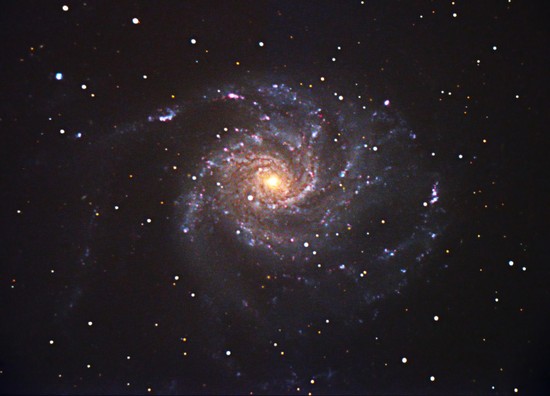Sky Viewing Blog
August 14, 2025
I am trying to get back to updating my web page. I have had some problems with the web development software, but I think I now have my problems corrected. I removed one of the links under my “Amateur Backyard Observatories” tab. That website had inappropriate links to other websites. I don’t feel that these links should be on this type of forum which should be about Astronomy. I apologize if anyone was offended by that web site that was linked by me. I will be more vigilant in the future.
January 11, 2025
I've been tryong to get some pictures, but in the Month of December, the skies were always cloudy. However, on December 7, when Jupiter was in Opposition. I was able to take the following picture. The moon Callisto was out of the field of view above the top corner. I have also placed this photo in the GalleryJupiter in Oppo9sition with the visible moons
October 16, 2024
Here is my latest shot of Comet Tsuchinshan-Atlas. The blue tint is because of the lightness of the dusk sky and the rising of the full moon. The interesting thing in this picture is that I also captured the M5 Globular Cluster at the left edge of the photograph. This picture also in the "Astrophotography Gallery" so it can be viewed in larger size.
Comet Tsuchinshan-Atlas and M5October 14, 2024
Well it looks likfe the Blaze Star did not show up in September like it was predicted. The Constellation Corona Borealis has set in the western sky and I am not sure if I can get a picture of the "Blaze Star" when it occurs. I have been busy though taking pictures of the Northern Lights while I was in Wyoming, and pictures of the Tsuchinshan=Atlas commet. The "Lights" were taien with my iPhone and the Big Dipper can be seen in the photo. I took the picture of the Comet on October 13, but only had about a 15 minute window before the clouds came in. The Comet picture was taken at full f/11 through the scope which gave a closeup, but not a wide view of the Comet. I will try again tonight and see if I can get a better wide angle shot of the comet. Hopefully the clouds will be nice tonight. Pictures of the comet and the Northern Lights are shown below.Northern Lights in WyomingComet Tsuchinshan-Atlas
August 28, 2024
I am in preparation for the Astromony event of a lifetime. That is when the "Blaze Star"turns Nova in the constallation Corona Borealis. Below is a picture of the area in which the Nova will appear. I am hoping that I can get a before and after picture of the event. This is just a star field if the star goes Nova. It should appear near the center of this picture during the event. I hope it happens before the constellation sets in the West.The Blaze Star should appear in the center of this image
April 10, 2024
I have returned from my mission for the church of Jesus Christ of latter-day Saints and my first StarGazing was of the Solar Eclipse on April 8, 2024. I took the pictures in Poplar Bluff Missouri. I used my Nikon D52 Camera with a 400 mm lens at f/8. I was so obsorbed watching the exlipse, I was late taking the picture of the "Diamond Ring". In my hast to get it, I shook the tripod, and the picture is a littlle out of focus. The results are below.
April 8, 2024 Full Eclipse
April 8, 2024 Diamond Ring Eclipse
February 4, 2023
It has been seven months since I last posted on this site. Sorry for the long delay. A lot has been happening and the night skies in my area have been terrible for viewing. We have had alot of rain and snow which we sorely needed. In October, our whole family went to Disneyland for a week and then when we returned, my wife and I accepted a call to serve a mission for the Church of Jesus Christ of latter-day Saints. That was in December and we have been preparing to leave for Anahem California on February 13.
As an interesting note, I did some study on the star of Bethlehem during Christ's birth. The Church of Jesus Christ of latter-day Saints believe Christ was born on April 6, at the meridian of time. with that in mind, I figured the new star could have been a supernova appearing at Christs birth. such an event would have been bright enough to be seen even in the day time and would slowly fade over the years. If a nova had existed, the program "Stellarium" could be set to the date and time of the birth of Christ as viewed from Jerusalem. On that date exactly due east of Jeerusalem which is only a few miles from Bethlehem, is a remanent of a supernova. It is known as the Veil Nebula which is shown below. Was this the Star of Bethlehem? Only our Father in Heaven knows. Stellarium cannot know exactly when the nova actually occurred, but it can show the remanent. I think it is interesting that exactly due east of Jerusalem is evidence that a nova could have occurred at the time of Christ's birth. I took a picture of the Veil Nebula in November 2020.
July 2, 2022Veil Nebula (Star of Bethlehem Remanent?)The Star Antares is the brightest star in the constellation Scorpius. Near Antares are two globular clusters. the larger cluster is named "Crab Globular Cluster" and the smaller cluster is designated NGC 6144. The seeing condition on this night was not good. The autoguider kept having problems with clouds. The image is shown below and a larger version can be seen in the Gallery. I used the HyperStar Lens so I could get all three objects in one picture.
The Star Antares and two Clusters
June 2, 2022
The Bubble Nebula NGC 7635 was the target of last night's imaging session. I used my HyperStar lens and stacked 68 images. Initially the nebula was low in the northern sky, but as the night progressed, it rose high enough to get a clear image. The image is shown below and is also posted in my gallery. The "Bubble" is prominent in this photo.Bubble Nebula (NGC 7635)
May 31, 2022
Today I finally got around to processing an astrophoto that I took on April 29, 2022. Below is M5 or the Rose Cluster. I have also placed this picture in my gallery so you can see a larger view
M5 (Rose Cluster)
May 24, 2022
Finally, a clear night. There have been high clouds for the last month at the Dry Creek View Observatory. These clouds prevented taking pictures of the recent solar eclipse. Fortunately, I have other pictures of the "Blood Moon". Last night I took pictures of the Southern Pinwheel Galaxy. The galaxy is shown below and is also in the Astrophotography Gallery.M 83 Southern PInwheel Galaxy
April 5, 2022
With the new mount ballanced, polar aligned and GOTO aligned, I emparked on taking a picture of Thors Helmet (NGC 2359). I took 15 images at 6400 ISO and a duration of 7 minutes each. The image is shown below and a larger version is in the galleryThors Helmet NGC 2359This week, I also added a major addition to my Observatory. For the last 11 years the lighting in the Scope Room condisted of 4 Can Lights with Red lights and 4 Can Lights with white lights. The problem is that the white lights would shine on the floor and I always needed a flashlight to adjust items on the scope. This week I installed 25 feet of LED strip lighting around the Dome Roller Ring. Below are before and after pictures with the new lights on and off. I can now clearly see the scope if any adjustments are needed.
Lights Off Lights On
March 26, 2022
Happy day!! On March 24, my new CGX-L Telescope Mount finally arrived. After 3 months of waiting, I unpacked the mount and installed it on my concrete pier. Thew Mount is shown below.Celestron CGX-L Telescope Mount
March 17, 2022
I received my CGX-L adapter plate this week and installed it on my 12-inch concrete pier. I had the plate manufactured by Dan's Pier Top Plates. The workmanship is great, and I would highly recommend them. The cost is a little pricy, but as you can imagine there is not a lot of market for telescope adapter plates. A picture of the plate is below. I added a link to "Dans Pier Top Plates" in the "Friendly Links" section at the bottom of my webpages.As for my CGX-L mount, I am still waiting. I ordered it on January 3, and it is now going on nearly 11 weeks. In eleven days, it will be 3 months.Adapter Plate for the Celestron CGX-L Mount
January 23, 2022
Alot has happpened since I last posted in December. First things first. I purchased a small solar panel to power my Eufy Security Camera outside the Observatory door. The battery lasts for about 4 months, but by having the solar panel, I do not need to manually charge the camera. The camera works well, but this is a convenience issue for me as I no longer need to worry about charging the camera. A picture of the small solar panel is shown below.Eufy Camera Solar PanelThe next thing that happened is that my CGE Mount that has been my work horse for the last 13 years is starting to have problems when the temperature is cold. The issue is with the "DEC" and "RA" cables coming from the mount computer to the mount motors. I have had problems with this in the past and Celestron sent me new cables. Instead of fighting this, I purchased the new CGX-L mount from Celestron. This new mount has more weight capacity and newer interfaces to the Warm Room Computer. The CGE mount still works, but I needed the extra capacity particularly when using my HyperStar Lens and my Nikon Camera. When loaded with these Items on my C 14 Scope and my Autoguider Scope, I was pushing the limits of the CGE Mount. The problem is, the wait times for the new mount. It is backorderd and I am not sure when it will arrive. I also needed a new mounting plate for my concrete pier. Both the mount and the plate are out at least 2 months.
December 5, 2021
I was going through my old photos that I have not posted on this new format web page. One of the pictures that I took in 2013 was of M1 the Crab Nebula. That picture on the left was taken with my first Camera a Nikon D3. The one on the right was taken with my Nikon D810A. Both pictures were taken with an ISO of 3200 and a shutter duration of 4.5 minutes. Each had 12 images stacked. A larger picture of the 2021 image has been placed in the gallery. It is worth expanding so you can see the detail.
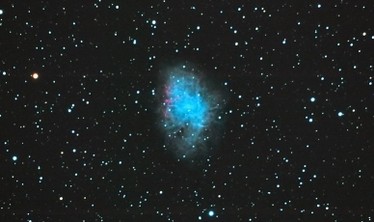
M1 Crab Nebula 2013 Nikon D3 M1 Crab Nebula 2021 Nikon D810A
October 7, 2021
Another picture I took on October 3. This is the Heart Nebula (IC 1805). Both the Heart Nebula and the North American Nebula have been placed in the Astrophotography Gallery under Nebulas. Click on the thumbnail for a larger view.Heart Nebula IC 1805
October 5, 2021
Finally, the smoke of the summer fires in California have passed and the dark skies have returned. On October 3, I took these pictures of the North American Nebula (NGC 7000). The image below and on the left is the full image which gives a vague pattern of North America from which the Nebula gets its name. With that image in mind, the image on the right would be Central America and is zoomed in on the most detail of the image.
North American Nebula NCC 7000
September 9, 2021
GoDaddy my web hosting provider stopped its free Email service and changed to Microsoft Email 365. The new basic service would have cost me $5.00 per month. I was not given a discount on my monthly hosting fee to which I am not happy. $5.00 per month will not break me, but it is the principle of the issue. I also refuse to purchase the new version of Adobe Photoshop because of the monthly subscription fee. I am using an old version which I purchased outright and it works just fine. Well, enough of my rant. To solve the Email problem, I created a Gmail account called, "dcvobservatory@gmail.com" and it is free. Any Emails sent to me by my old email "travis@dcvobservatory.com" after September 3, will not work. I have also updated the "Contact Me" section of the web page to reflect the new Email address.
August 26, 2021
I'm sorry for not posting anything for the last several months. The problem has been the fires in California. Here in central Utah, the smokey haze has all but made it impossible to look at the night skies. I wanted to take a picture of Saturn at Opposition on August 9, but the haze was so smokey that I couldn't see the planet with the naked eye. I have missed a whole summer of viewing and picture taking due to this smoke. I know it seems strange, but with the fires over 600 miles away, the weather patterns bring the smoke right through Utah. So, to use a cliche, "When the Smoke Clears", I will get back to taking pictures.
January 17, 2021
Last night I was observing and taking pictures of the jewel of the winter skies M 42 or the Orion Nebula. I took many pictures of this nebula at full 3910 focal length of my telescope. I will process this close up later. I then found M 74 or the “Phantom Galaxy” in the constellation Pisces. It is approximately 32 million light-years from earth. The picture below is the galaxy.
M 74 the "Phantom Galaxy"January 6, 2021
My target for the night was the Sculptor Galaxy located in the Sculptor Constellation in the low southern sky. I have taken a picture of this galaxy before, but this time I used the full power of my 14-inch scope at 3910 mm focal length. This allows for a magnified image, but is difficult to focus and requires longer exposure times. I like the way this image turned out. I shot it with my Nikon D800A camera and was auto guided. The exposure time was 2 minutes at ISO 3200. Fifteen images were stacked using ImagesPlus 6.5. The picture is shown below.Sculptor Galaxy (NGC 253)
December 30, 2020
I installed a new weather station at the Dry Creek View Observatory. To access this station, I have placed a button at the bottom of each page titled. "Observatory Weather". This will take you to another web page with the data displayed from the Dry Creek View weather station. It takes a few seconds for the data to be displayed on the new page.
December 25, 2020
Merry Christmas to all. I did get a chance to take a picture of the Conjunction of Jupiter and Saturn. I was able to get the picture with my 2X Barlow lens attached to my Camera and Scope. I took the picture on December 21, at around 6:00 PM MST. I like the way this picture turned out. Saturn is a little dark, and Jupiter is a little bright, but that is how it was. I used my Nikon D 810A in movie mode and shot the movie for about 90 seconds. I stacked the movie frames using ImagesPlus and processed the picture using Adobe CS2 and Nikon NX2 Software. The moons of Jupiter are (top Left to Bottom Right) Callisto, IO, and Europa. The moon Ganymede is in front off Jupiter. The picture is shown below.
Conjunction of Jupiter and Saturn (12-21-20)December 7, 2020
The California Nebula (NGC 1499) is an emission nebula in the constellation Perseus. I processed the picture below of the California Nebula by using two different post processing programs. I took 38 light frames and opened them in the program ImagesPlus 6.5. I auto stretched (brightened up the Nebula) of each of the 38 photos. Then I "Normalized, Aligned, and Stacked" each of the photos. I then opened the stacked image and did more post processing with the program Nikon NX2. I set my Nikon 810A camera to DX mode with a 30 second shutter and 1600 ISO for each of the light frames. My 14-inch Celestron scope had the HyperStar Lens attached giving a focal ratio of f/2. The final processed photo is shown below. The image is also in my gallery where it can be enlarged.California Nebula NGC 1499
November 18, 2020
I actually took this picture the same night I took the picture of the Horsehead Nebula. It was an after thought and I only took 6 light frames. Due to the clear night, I like the way this picture turned out. The focus was good and very little post processing was needed. During stacking of the light frames I used 6 flat frames to normalize the edges of the picture so the corners are not so dark. The picture is below and is also in my gallery.Pleiades
November 16, 2020
I have taken photographs of the Flame and Horsehead nebula in the constallation Orion, but tonight, I focused just on the Horsehead. I took 34 light frame pictures and stacked and post processed using ImagesPlus software. I finished the processing using Nikon Capture NX2 so that I could crop and frame the picture. The resultant photograph is shown below and also shown in my gallery.Horsehead Nebula
November 12, 2020
Tonight, my target of interest was the Veil Nebula in the constellation Cygnus. Before I took this picture, I used my Nighttime Imaging 'N' Astronomy (NINA) software to get a good focus on the object. This software worked well, but it took a long time to completely sharpen the stars as I was not even close to sharp focus to begin with. To achieve a low HFR (Half Fulx Radius) when focusing with NINA, my HFR started out at 7.5 and got as low as 3.2 when it was finished. The lower HFR number the better, but it took nearly 1 hour to achieve the 3.2 number. My suggestion is to get as sharp of focus as you can then begin the Nina Autofocus routine. See my post on August 22, to see what equipment is needed for autofocusing.My picture of the Veil Nebula is below. This nebula is hidden in a Sea of Stars.Veil Nebula
October 13, 2020
As stated in my post of September 20, I couldn't get a good picture of the planets. After a month the skies cleared on October 11, so that I could get a picture of Mars in "Opposition". The picture is shown below.Mars
To get the picture of Mars, I used my 4x Televue Barlow lens with my Nikon D810A camera. When taking pictures of planets, you must use video instead of a single shot. This is because of the oscillation of the planet due to the earth's atmosphere. That is why I couldn't get a good picture with the hazy smoky skies. I took a 3-minute video at a resolution of 1920 x 1080 and 60 frames per second. This gave me about 11,000 frames to choose from to get the best focused image. In order to get the best images of over 11,000 frames, I used the program "ImagesPlus". This program analyzes the individual frames then I selected the best 5% of those frames to have the program "Stack" and "Align". The result is what you see above. I have also placed this picture in my Gallery.
September 20, 2020
With all of the smoke in the skies from the fires in California, I can't get a good focus on the planets of Mars, Jupiter and Saturn. Yes, those fires are affecting the "seeing" here in Utah. However, with the dark skies, I can get pictures of some deep sky objects. Last night I had to try and get some Astrophotos even though the skies were hazy. It was hazy, but dark. I guess one out of two atmospheric conditions isn't bad. My target was M 33 the Triangulum Galaxy. Below is my photo.M 33 "Triangulum Galaxy"
September 6, 2020
Today, I did some cleanup of the web page. I realized I had put the blog dates from oldest to newest posts. I changed that to the reverse order so that the newest posts are at the top.During the past few weeks, I have been imaging the planets Saturn and Jupiter. For those out there who are having trouble getting a clear focus on these planets either for viewing or photo taking, take heart, it is not your equipment. Even though I am located in central Utah, the wild fires in California are causing "Seeing or Clarity" problems in the atmosphere. The planets look like they are boiling or pulsating. This makes clearly focusing nearly impossible. Hopefully the skys will clear and I will be able to take some "clearly focused" pictures.
August 22, 2020
Yesterday, I had a lot of fun in the observatory. A few years ago, I purchased a "Micro-Touch" wireless focuser from Starizona. This has been handy as I can manually focus the scope from the warm room by using "Live View" from my camera. I finally looked into the "Focus Max" software that came with the Micro-Touch. The software was easy to install, but I found out that I needed additional software from MaximDL at a cost of $499 to run my camera with the focuser. That was not acceptable to me so the search began to find a program that works with the Micro-Touch focuser and will interface with my Nikon D810A. I found such a program called NINA (Nighttime Imaging "N" Astronomy) which can be downloaded at https://nighttime-imaging.eu/. This software interfaced well with my Camera and the Micro-Touch focuser. I was actually able to autofocus my image in very poor seeing conditions and at full 3010 mm focal length of my Telescope. That setup is the most difficult for astrophotography with my equipment. Best of all it was free. Below is a picture I took after the autofocus was complete. It is the Swan Nebula M 17.M 17 "Swan Nebula"August 12, 2020
Last night I took the time to do some astrophotography. My target was M 101 the “Pinwheel” galaxy. I had my scope set up at f/11 3900mm focal length with my CGE 1400 Telescope. I was not happy with the image that I captured. At an ISO of 3200, and 6 pictures stacked, the image was too grainy for me and a little out of focus. Below is the processed image. I will try another night to get a sharper less grainy image.M 101 "Pinwheel Galaxy"
July 31, 2020For the past 3 weeks, I have been "Re-Developing" the Dry Creek View Observatory Web Page. I moved from an old web builder which I have been using for the past 8 years to a new developing software called "WebSite X5 evo. My old web blogs over the years will be archived by me and used as a personal history of my astronomy activities. These older blogs will no longer be available on my web page. Therefore, I am starting new with this July 31, 2020 entry.I will be following a similar format to the old web page, but new and I hope better pictures will be forthcoming. I will be posting higher resolution photos so they can be better seen when zooming in for detail.As I am now retired from my day job, I hope to be doing much more star gazing and astrophotography. My home page will indicate when my pages are updated under the heading "Most Recent Updates". Check back soon as I plan on taking some classic pictures of the sky at higher resolution. Clear Skies, Travis Smith


